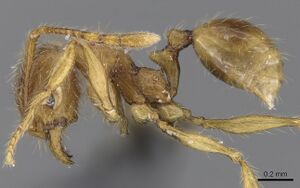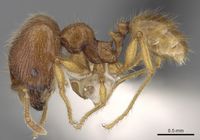Pheidole tandjongensis
| Pheidole tandjongensis | |
|---|---|

| |
| Scientific classification | |
| Kingdom: | Animalia |
| Phylum: | Arthropoda |
| Class: | Insecta |
| Order: | Hymenoptera |
| Family: | Formicidae |
| Subfamily: | Myrmicinae |
| Tribe: | Attini |
| Genus: | Pheidole |
| Species: | P. tandjongensis |
| Binomial name | |
| Pheidole tandjongensis Forel, 1913 | |
This species has been collected nesting together with Odontomachus rixosus (Satria et al. 2015).
Identification
Distribution
Latitudinal Distribution Pattern
Latitudinal Range: 21.92802778° to 13.128943°.
| North Temperate |
North Subtropical |
Tropical | South Subtropical |
South Temperate |
- Source: AntMaps
Distribution based on Regional Taxon Lists
Indo-Australian Region: Indonesia (type locality), Singapore.
Oriental Region: Thailand, Vietnam.
Palaearctic Region: China.
Distribution based on AntMaps
Distribution based on AntWeb specimens
Check data from AntWeb
Countries Occupied
| Number of countries occupied by this species based on AntWiki Regional Taxon Lists. In general, fewer countries occupied indicates a narrower range, while more countries indicates a more widespread species. |

|
Estimated Abundance
| Relative abundance based on number of AntMaps records per species (this species within the purple bar). Fewer records (to the left) indicates a less abundant/encountered species while more records (to the right) indicates more abundant/encountered species. |

|
Biology
Castes
Worker
Minor
Images from AntWeb
   
| |
| Worker. Specimen code casent0281721. Photographer Estella Ortega, uploaded by California Academy of Sciences. | Owned by NHMUK, London, UK. |
   
| |
| Syntype of Pheidole tandjongensis. Worker. Specimen code casent0904245. Photographer Will Ericson, uploaded by California Academy of Sciences. | Owned by MSNG, Genoa, Italy. |
   
| |
| Paralectotype of Pheidole tandjongensis. Worker. Specimen code casent0908002. Photographer Z. Lieberman, uploaded by California Academy of Sciences. | Owned by MHNG, Geneva, Switzerland. |
    
| |
| Not Provided. Worker. Specimen code antweb1008112. Photographer Adam Lazarus, uploaded by California Academy of Sciences. | Owned by EPEC. |
Major
Images from AntWeb
   
| |
| Lectotype of Pheidole tandjongensis. Worker (major/soldier). Specimen code casent0908001. Photographer Z. Lieberman, uploaded by California Academy of Sciences. | Owned by MHNG, Geneva, Switzerland. |
Nomenclature
The following information is derived from Barry Bolton's Online Catalogue of the Ants of the World.
- tandjongensis. Pheidole tandjongensis Forel, 1913k: 42 (s.w.) INDONESIA (Sumatra). See also: Eguchi, 2001a: 27.
Unless otherwise noted the text for the remainder of this section is reported from the publication that includes the original description.
Description
Worker
Eguchi (2001) - Major (lectotype). Measurements: HL 0.94 mm; HW 0.89 mm; SL 0.66 mm; FL 0.57 mm; CI 95; SI 74; R 64. Head broadest at about 3/5 distance of head (from anterior margin of clypeus to posterior margin of occipital lobe) (Fig. 17A), in profile not impressed on vertex (Fig. 17B); occipital lobe ill developed (Fig. 17A); anteroventral margin of cranium bearing a pair of long median processes. Clypeus without a median longitudinal carina. Eye 0.13 mm in maximal diameter, situated at about 2/5 distance of head; distance between mandibular insertion and anterior margin of eye 1.5 times as long as maximal diameter of eye (Fig. 17B). Frontal carina very weak, extending to about 4/5 distance of head. Antennal scrobe present only around antennal insertion. Antenna with 3-segmented club; scape reaching about 4/5 distance of head; terminal segment ca. 1.1 times as long as preceding two segments together. Masticatory margin of mandible with apical and preapical teeth, and an indistinct denticle in front of basal angle. Promesonotum forming a high dome, without a prominence on its posterior declivity (Fig. 17C); dorsal portion of the dome not produced laterally. Mesopleuron divided into two parts; the lower part distinctly marginate dorsally (Fig. 17C). Propodeal spine hom -like, ca. 1.5 times as long as diameter of propodeal spiracle. Petiole ca. 1.9 times as long as postpetiole (excluding helcium); petiolar node high, in posterior view not emarginate at apex (Fig. 17C). Postpetiole high, ca. 1.3 times as broad as petiolar node. Dorsum of head almost entirely rugose (Fig. 17A), with interspaces smooth and shining; lateral face of occipital lobe smooth and shining; alitrunk largely smooth and shining; petiolar pedicel very weakly punctured; the remainder of petiole, and postpetiole and gaster smooth and shining. Body light brown.
Minor (paralectotypes). Measurements: HL 0.54-0.56 mm; HW 0.51-0.52 mm; SL 0.58-0.61 mm; AL 0.70-0.73 mm; FL 0.57-0.61 mm; CI 91-96; SI 112-117; R 110-117. Head in full-face view almost straight posteriorly (Fig. 17D); occipital carina evanescent dorsally on the head. Clypeus without a median longitudinal carina. Eye situated at about midlength of head; distance between mandibular insertion and anterior margin of eye 1.0-1.1 times as long as maximal diameter of eye (Fig. 17E). Antenna with 3-segmented club; in full-face view scape extending beyond posterior border of head by its 1/4 length; terminal segment 1.0-1.1 times as long as preceding two segments together. Promesonotum weakly convex dorsally, without any prominence on its posterior declivity (Fig. 17F). Mesopleuron divided into two parts; the lower part distinctly marginate dorsally. Propodeal spine ca. 1.5 times as long as diameter of propodeal spiracle. Petiole 1.9-2 times as long as postpetiole (excluding helcium); petiolar node high, in posterior view not emarginate at apex. Postpetiole high, ca. 1.3 times as broad as petiolar node. Head smooth and shining; alitrunk largely smooth and shining; petiolar pedicel very weakly punctured, but shining; the remainder of petiole, and postpetiole and gaster smooth and shining. Body light brown.
Type Material
Eguchi (2001) - Major and minor; type locality: Tanjong Slamat, Sumatra. Four syntypes (1 major and 3 minors, Musee d'Histoire Naturelle Genève) were examined, of which the major is designated as the lectotype.
References
- Eguchi, K. 2001b. A taxonomic study on Asian Pheidole (Hymenoptera, Formicidae): new synonymy, rank changes, lectotype designations and redescriptions. Insecta Koreana. 18:1-35.
- Eguchi, K. 2003. A Study on the Male Genitalia of Some Asian Species of Pheidole (Hymenoptera, Formicidae, Myrmicinae). Sociobiology 41(2): 317-355 (page 337, figs. 28A, B male genitalia described)
- Forel, A. 1913l. Wissenschaftliche Ergebnisse einer Forschungsreise nach Ostindien ausgeführt im Auftrage der Kgl. Preuss. Akademie der Wissenschaften zu Berlin von H. v. Buttel-Reepen. II. Ameisen aus Sumatra, Java, Malacca und Ceylon. Gesammelt von Her (page 42, soldier, worker described)
- Khachonpisitsak, S., Yamane, S., Sriwichai, P., Jaitrong, W. 2020. An updated checklist of the ants of Thailand (Hymenoptera, Formicidae). ZooKeys 998, 1–182 (doi:10.3897/zookeys.998.54902).
- Satria, R. 2017. Taxonomy of the ant genus Odontomachus (Hymenoptera: Formicidae: Ponerinae) in the Indo-Chinese and Indo-Malayan subregions. Ph.D. thesis, Tokyo Metropolitan University.
- Satria, R., Kurushima, H., Herwina, H., Yamane, S. and Eguchi, K. 2015. The trap-jaw ant genus Odontomachus Latreille from Sumatra, with a new species description. Zootaxa. 4048: 1-36.
- Wang, W.Y., Soh, E.J.Y., Yong, G.W.J., Wong, M.K.L., Benoit Guénard, Economo, E.P., Yamane, S. 2022. Remarkable diversity in a little red dot: a comprehensive checklist of known ant species in Singapore (Hymenoptera: Formicidae) with notes on ecology and taxonomy. Asian Myrmecology 15: e015006 (doi:10.20362/am.015006).
References based on Global Ant Biodiversity Informatics
- Chapman, J. W., and Capco, S. R. 1951. Check list of the ants (Hymenoptera: Formicidae) of Asia. Monogr. Inst. Sci. Technol. Manila 1: 1-327
- Eguchi K. 2001. A taxonomic study on Asian Pheidole (Hymenoptera, Formicidae): new synonymy, rank changes, lectotype designations and redescriptions. Insecta Koreana 18: 1-35.
- Eguchi K. 2003. A study on the male genitalia of some Asian species of Pheidole (Hymenoptera, Formicidae, Myrmicinae). Sociobiology 41: 317-355.
- Eguchi K.; Bui T. V.; Yamane S. 2011. Generic synopsis of the Formicidae of Vietnam (Insecta: Hymenoptera), part I Myrmicinae and Pseudomyrmecinae. Zootaxa 2878: 1-61.
- Forel A. 1913k. Wissenschaftliche Ergebnisse einer Forschungsreise nach Ostindien ausgeführt im Auftrage der Kgl. Preuss. Akademie der Wissenschaften zu Berlin von H. v. Buttel-Reepen. II. Ameisen aus Sumatra, Java, Malacca und Ceylon. Gesammelt von Herrn Prof. Dr. v. Buttel-Reepen in den Jahren 1911-1912. Zoologische Jahrbücher. Abteilung für Systematik, Geographie und Biologie der Tiere 36:1-148.
- Ito, F.; Yamane, S.; Eguchi, K.; Noerdjito, W. A.; Kahono, S.; Tsuji, K.; Ohkawara, K.; Yamauchi, K.; Nishida, T.; Nakamura, K. 2001. Ant species diversity in the Bogor Botanic Garden, West Java, Indonesia, with descriptions of two new species of the genus Leptanilla (Hymenoptera, Formicidae). Tropics 10:379-404.
- Jaitrong W., and T. Ting-Nga. 2005. Ant fauna of Peninsular Botanical Garden (Khao Chong), Trang Province, Southern Thailand (Hymenoptera: Formicidae). The Thailand Natural History Museum Journal 1(2): 137-147.
- Jaitrong W.; Nabhitabhata, J. 2005. A list of known ant species of Thailand. The Thailand Natural History Museum Journal 1(1): 9-54.
- Satria R., H. Kurushima, H. Herwina, S. Yamane, and K. Eguchi. 2015. The trap-jaw ant genus Odontomachus Latreille (Hymenoptera: Formicidae) from Sumatra, with a new species description. Zootaxa 4048(1): 001-036.
- Watanasit S., J. Saewai, and A. Philapplueng. 2007. Ants of the Klong U-Tapao Basin, Southern Thailand. Asian Myrmecology 1: 69-79.
- Watanasit S., Noon-anant N., and N. Binnima. 2005. Preliminary survey of ants at a reserve area of Prince of Songkla University, Songkhla Provinces, Southern Thailand. Songklanakarin J. Sci. Technol. 27(1): 39-46.
- Watanasit S., and T. Nhu-eard. 2011. Diversity of ants (Hymenoptera: Formicidae) in two rubber plantations in Songkhla Province, Soutern Thailand. Songklanakarin J. Sci. Technol. 33(2): 151-161.


